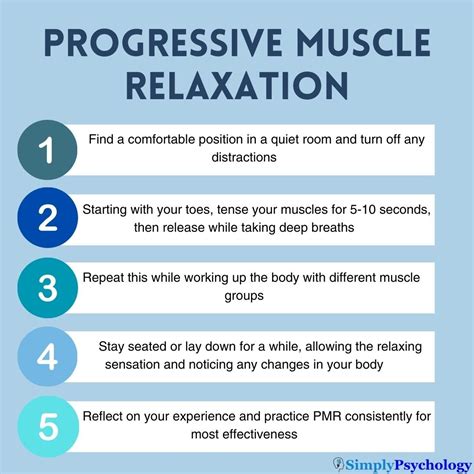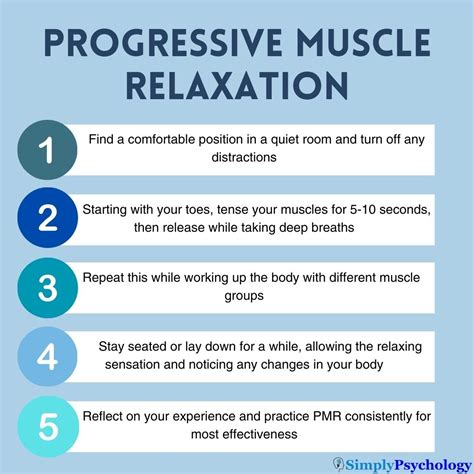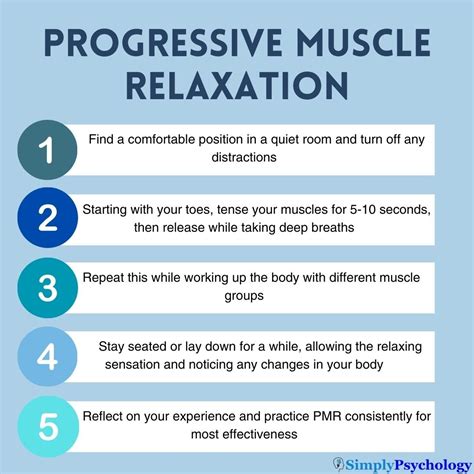Intro
Discover the Progressive Muscle Relaxation Technique, a powerful stress relief method using deep breathing, mindfulness, and tension release to calm muscles, reduce anxiety, and promote relaxation.
The Progressive Muscle Relaxation (PMR) technique has been widely recognized as a valuable tool for managing stress, anxiety, and promoting overall well-being. Developed by American physician Edmund Jacobson in the 1920s, PMR involves a systematic approach to relaxing the body's muscles, which in turn, calms the mind. This technique has been extensively used in various therapeutic settings, including psychology, physiotherapy, and occupational therapy. By understanding the principles and benefits of PMR, individuals can incorporate this simple yet effective technique into their daily lives, leading to improved physical and mental health.
The importance of relaxation techniques cannot be overstated, especially in today's fast-paced world. With the constant demands of work, social media, and personal responsibilities, it's easy to get caught up in a cycle of stress and tension. Chronic stress can lead to a range of negative consequences, including anxiety, depression, insomnia, and a weakened immune system. PMR offers a practical solution to mitigate these effects, providing a sense of calm and control over one's body and mind. By learning to relax and release physical tension, individuals can better navigate life's challenges, improve their relationships, and enhance their overall quality of life.
As the benefits of PMR continue to gain recognition, it's essential to explore the technique in more depth. PMR is based on the idea that physical relaxation can lead to mental relaxation, and vice versa. By systematically tensing and relaxing different muscle groups, individuals can release physical tension, reduce anxiety, and promote a sense of calm. This technique is particularly useful for individuals who struggle with mindfulness or meditation, as it provides a more concrete and physical approach to relaxation. Whether you're looking to manage stress, improve sleep, or simply feel more relaxed and centered, PMR is an excellent technique to explore.
Understanding Progressive Muscle Relaxation

To practice PMR, it's essential to understand the basic principles and steps involved. The technique typically involves tensing and relaxing different muscle groups, starting with the toes and moving up to the head. Each muscle group is tensed for a few seconds, followed by a release and relaxation phase. This process helps to release physical tension, reduce muscle soreness, and promote a sense of calm. By focusing on the physical sensations in the body, individuals can quiet the mind and enter a state of deep relaxation.
Benefits of Progressive Muscle Relaxation
The benefits of PMR are numerous and well-documented. Some of the most significant advantages include: * Reduced stress and anxiety * Improved sleep quality * Increased feelings of relaxation and calm * Reduced muscle tension and pain * Improved mood and overall sense of well-being * Enhanced self-awareness and body awareness * Improved focus and concentrationHow to Practice Progressive Muscle Relaxation

To practice PMR, follow these steps:
- Find a quiet and comfortable space to relax, free from distractions and interruptions.
- Start by tensing the muscles in your toes, holding for 5-10 seconds.
- Release the tension and feel the relaxation spread through your toes.
- Move up the body, tensing and relaxing each muscle group in turn, including the feet, calves, thighs, hips, back, shoulders, arms, hands, neck, and head.
- Focus on the physical sensations in each muscle group, noticing any areas of tension or relaxation.
- Practice deep, slow breathing, inhaling through the nose and exhaling through the mouth.
- Continue to practice PMR for 15-20 minutes, or until you feel deeply relaxed and calm.
Tips for Effective Progressive Muscle Relaxation
To get the most out of PMR, keep the following tips in mind: * Start with short sessions and gradually increase the duration as you become more comfortable with the technique. * Focus on the physical sensations in each muscle group, rather than trying to relax or achieve a specific state. * Use a gentle and gradual approach when tensing and relaxing each muscle group. * Practice PMR regularly, ideally at the same time each day, to make it a consistent part of your routine. * Be patient and persistent, as it may take some time to develop the skill and notice significant benefits.Common Challenges and Modifications

While PMR is a relatively simple technique, some individuals may encounter challenges or difficulties when practicing. Common issues include:
- Difficulty relaxing or releasing tension in certain muscle groups
- Feeling self-conscious or awkward when practicing PMR
- Struggling to focus or quiet the mind
- Experiencing physical discomfort or pain when tensing or relaxing certain muscle groups
To address these challenges, consider the following modifications:
- Start with shorter sessions and gradually increase the duration as you become more comfortable with the technique.
- Use guided recordings or apps to help you stay focused and on track.
- Practice PMR in a group setting or with a partner to provide support and motivation.
- Modify the technique to suit your individual needs and preferences, such as focusing on specific muscle groups or using different breathing techniques.
Progressive Muscle Relaxation for Specific Conditions
PMR has been shown to be effective in managing a range of conditions, including: * Anxiety and depression * Insomnia and sleep disorders * Chronic pain and fibromyalgia * Post-traumatic stress disorder (PTSD) * Attention deficit hyperactivity disorder (ADHD)By incorporating PMR into your treatment plan, you can experience significant improvements in symptoms and overall quality of life. Consult with a healthcare professional to determine the best approach for your specific condition and needs.
Conclusion and Next Steps

In conclusion, PMR is a powerful technique for managing stress, anxiety, and promoting overall well-being. By understanding the principles and benefits of PMR, individuals can incorporate this simple yet effective technique into their daily lives, leading to improved physical and mental health. Whether you're looking to manage stress, improve sleep, or simply feel more relaxed and centered, PMR is an excellent technique to explore. With regular practice and patience, you can experience significant benefits and improvements in your overall quality of life.
We invite you to share your experiences and thoughts on PMR in the comments below. Have you tried PMR before? What benefits have you noticed? Do you have any tips or modifications to share with others? Join the conversation and help others discover the power of PMR.
What is Progressive Muscle Relaxation?
+Progressive Muscle Relaxation (PMR) is a technique used to manage stress, anxiety, and promote overall well-being by systematically tensing and relaxing different muscle groups.
How do I practice Progressive Muscle Relaxation?
+To practice PMR, find a quiet and comfortable space, tense and relax each muscle group in turn, starting with the toes and moving up to the head, and focus on the physical sensations in each muscle group.
What are the benefits of Progressive Muscle Relaxation?
+The benefits of PMR include reduced stress and anxiety, improved sleep quality, increased feelings of relaxation and calm, reduced muscle tension and pain, and improved mood and overall sense of well-being.
